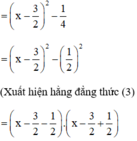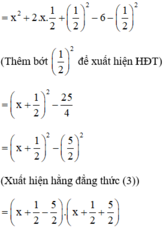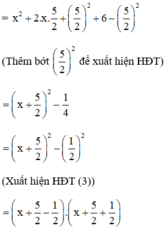phân tích các đa thức sau thành nhân tử :
1, x2 - 3x
2, x2 + 2x +1 - y2
3, x2 - 3x +2
Phân tích các đa thức sau thành nhân tử:
4x2y2 - ( x2 + y2 - a2)2
x3 - 1 + 5x2 - 5 +3x - 3
( x - y)2 + 4(x-y) + 4
x2 -2x( 3x+1) + (3x+1)2
x4 + 2x2(2x+1) + ( 2x+1)2
\(\left(x-y\right)^2+4\left(x-y\right)+4\)
\(=\left(x-y\right)^2+2.\left(x-y\right).2+2^2\)
\(=\left(x-y+2\right)^2\)
hk tốt
^^
Bài 3: Phân tích các đa thức sau thành nhân tử:
a) x2 + 10x + 25. b) 8x - 16 - x2
c) x3 + 3x2 + 3x + 1 d) (x + y)2 - 9x2
e) (x + 5)2 – (2x -1)2
Bài 4: Tìm x biết
a) x2 – 9 = 0 b) (x – 4)2 – 36 = 0
c) x2 – 10x = -25 d) x2 + 5x + 6 = 0
Bài 3
a) x² + 10x + 25
= x² + 2.x.5 + 5²
= (x + 5)²
b) 8x - 16 - x²
= -(x² - 8x + 16)
= -(x² - 2.x.4 + 4²)
= -(x - 4)²
c) x³ + 3x² + 3x + 1
= x³ + 3.x².1 + 3.x.1² + 1³
= (x + 1)³
d) (x + y)² - 9x²
= (x + y)² - (3x)²
= (x + y - 3x)(x + y + 3x)
= (y - 2x)(4x + y)
e) (x + 5)² - (2x - 1)²
= (x + 5 - 2x + 1)(x + 5 + 2x - 1)
= (6 - x)(3x + 4)
Bài 4
a) x² - 9 = 0
x² = 9
x = 3 hoặc x = -3
b) (x - 4)² - 36 = 0
(x - 4 - 6)(x - 4 + 6) = 0
(x - 10)(x + 2) = 0
x - 10 = 0 hoặc x + 2 = 0
*) x - 10 = 0
x = 10
*) x + 2 = 0
x = -2
Vậy x = -2; x = 10
c) x² - 10x = -25
x² - 10x + 25 = 0
(x - 5)² = 0
x - 5 = 0
x = 5
d) x² + 5x + 6 = 0
x² + 2x + 3x + 6 = 0
(x² + 2x) + (3x + 6) = 0
x(x + 2) + 3(x + 2) = 0
(x + 2)(x + 3) = 0
x + 2 = 0 hoặc x + 3 = 0
*) x + 2 = 0
x = -2
*) x + 3 = 0
x = -3
Vậy x = -3; x = -2
Câu 1
Rút gọn các biểu thức sau:
a. 2x(3x + 2) - 3x(2x + 3)
b. (x + 2)3 + (x - 3)2 - x2(x + 5)
c. (3x3 - 4x2 + 6x) : 3x
Câu 2
Phân tích đa thức sau thành nhân tử: 2x3 - 12x2 + 18x
Câu 3
Tìm x, biết: 3x(x - 5) - x2 + 25 = 0
Câu 4 Cho hình bình hành ABCD (AB > AD). Gọi E và K lần lượt là trung điểm của CD và AB. BD cắt AE, AC, CK lần lượt tại N, O và I. Chứng minh rằng:
a. Tứ giắc AECK là hình bình hành.
b. Ba điểm E, O, K thẳng hàng.
c. DN = NI = IB
d. AE = 3KI
Câu 5 Cho x, y là hai số thực tùy ý, tìm giá trị nhỏ nhất của biểu thức sau:
P = x2 + 5y2 + 4xy + 6x + 16y + 32
Câu 1:
a) 2x(3x+2) - 3x(2x+3) = 6x^2+4x - 6x^2-9x = -5x
b) \(\left(x+2\right)^3+\left(x-3\right)^2-x^2\left(x+5\right)\)
\(=x^3+6x^2+12x+8+x^2-6x+9-x^3-5x^2\)
\(=2x^2+6x+17\)
c) \(\left(3x^3-4x^2+6x\right)\div\left(3x\right)=x^2-\dfrac{4}{3}x+2\)
Câu 2:
\(2x^3-12x^2+18x=2x\left(x^2-6x+9\right)=2x\left(x^2-2.x.3+3^2\right)=2x\left(x-3\right)^2\)
Bài 2: Phân tích các đa thức sau thành nhân tử
a, (x2 -4)(x2 -10)-72
b, (x+1)(x+2)(x+3)(x+4)+1
c, (x2 +3x+1)(x2+3x-3)-5
a) \(=x^4-14x^2+40-72=x^4-14x^2-32=\left(x-4\right)\left(x+4\right)\left(x^2+2\right)\)
b) \(=\left(x^2+5x+4\right)\left(x^2+5x+6\right)+1=\left(x^2+5x\right)^2+2\left(x^2+5x\right)+1=\left(x^2+5x+1\right)^2\)
c) \(=x^4+3x^3-3x^2+3x^3+9x^2-9x+x^2+3x-3-5=x^4+6x^3+7x^2-6x-8=\left(x-1\right)\left(x+1\right)\left(x+2\right)\left(x+4\right)\)
a: Ta có: \(\left(x^2-4\right)\left(x^2-10\right)-72\)
\(=x^4-14x^2-32\)
\(=\left(x^2-16\right)\left(x^2+2\right)\)
\(=\left(x-4\right)\left(x+4\right)\left(x^2+2\right)\)
b: Ta có: \(\left(x+1\right)\left(x+2\right)\left(x+3\right)\left(x+4\right)+1\)
\(=\left(x^2+5x+6\right)\left(x^2+5x+4\right)+1\)
\(=\left(x^2+5x\right)^2+10\left(x^2+5x\right)+24+1\)
\(=\left(x^2+5x+1\right)^2\)
Phân tích đa thức thành nhân tử:
a) 4 x 2 - 12xy + 9 y 2 - 8x + 12y,
b)3 x 2 + 20x - 7;
c) ( 3 x - 1 ) 4 + 2(9 x 2 - 6x + 1) + 1;
d) 2 x 3 -3 x 2 +2x - 1.
Bài 1: Phân tích các đa thức sau thành nhân tử
a) 2x2 - xy + 2x - y
b) ac + bc - 2 (a + b)
c) x2 + 4xy + 2x + 8y
d) x2 + 2xy + 3x + 6y
\(a,=x\left(2x-y\right)+\left(2x-y\right)=\left(x+1\right)\left(2x-y\right)\\ b,=\left(a+b\right)\left(c-2\right)\\ c,=x\left(x+4y\right)+2\left(x+4y\right)=\left(x+2\right)\left(x+4y\right)\\ d,=x\left(x+2y\right)+3\left(x+2y\right)=\left(x+3\right)\left(x+2y\right)\)
Phân tích các đa thức sau thành nhân tử:
a) x2 – 3x + 2
b) x2 + x – 6
c) x2 + 5x + 6
Cách 1: Tách một hạng tử thành tổng hai hạng tử để xuất hiện nhân tử chung.
a) x2 – 3x + 2
= x2 – x – 2x + 2 (Tách –3x = – x – 2x)
= (x2 – x) – (2x – 2)
= x(x – 1) – 2(x – 1) (Có x – 1 là nhân tử chung)
= (x – 1)(x – 2)
Hoặc: x2 – 3x + 2
= x2 – 3x – 4 + 6 (Tách 2 = – 4 + 6)
= x2 – 4 – 3x + 6
= (x2 – 22) – 3(x – 2)
= (x – 2)(x + 2) – 3.(x – 2) (Xuất hiện nhân tử chung x – 2)
= (x – 2)(x + 2 – 3) = (x – 2)(x – 1)
b) x2 + x – 6
= x2 + 3x – 2x – 6 (Tách x = 3x – 2x)
= x(x + 3) – 2(x + 3) (có x + 3 là nhân tử chung)
= (x + 3)(x – 2)
c) x2 + 5x + 6 (Tách 5x = 2x + 3x)
= x2 + 2x + 3x + 6
= x(x + 2) + 3(x + 2) (Có x + 2 là nhân tử chung)
= (x + 2)(x + 3)
Cách 2: Đưa về hằng đẳng thức (1) hoặc (2)
a) x2 – 3x + 2

(Vì có x2 và  nên ta thêm bớt
nên ta thêm bớt  để xuất hiện HĐT)
để xuất hiện HĐT)

= (x – 2)(x – 1)
b) x2 + x - 6

= (x – 2)(x + 3).
c) x2 + 5x + 6

= (x + 2)(x + 3).
Phân tích các đa thức sau thành nhân tử:
a,x3+4x-5
b,x3-3x2+4
c,x3+2x2+3x+2
d,x2+2xy+y2+2x-2y-3
e,(x2+3x)2-2(x2+3x)-8
f,(x2+4x+10)2-7(x2+4x+11)+7
a) x3+4x-5 = x3-x2+x2+4x-5=(x3-x2)+(x2-x)+(5x-5)=x2(x-1)+x(x-1)+5(x-1)=(x2+x+5)(x-1)
b) x3-3x2+4=x3-2x2-x2+4=(x3-2x2)-(x2-4)=x2(x-2)-(x-2)(x+2)=(x2-x+2)(x-2)
c) x3+2x2+3x+2=x3+x2+x2+x+2x+2=(x3+x2)+(x2+x)+(2x+2)=x2(x+1)+x(x+1)+2(x+1)=(x2+x+2)(x+1)
d) bạn xem lại đề đúng ko
e) (x2+3x)2-2(x2+3x)-8=x4+6x3+9x2-2x2-6x-8=x4+6x3+7x2-6x-8=x4-x3+7x3-7x2+14x2-14x+8x-8=(x4-x3)+(7x3-7x2)+(14x2-14x)+(8x-8)=x3(x-1)+7x2(x-1)+14x(x-1)+8(x-1)=(x3+7x2+14x+8)(x-1)=(x3+x2+6x2+6x+8x+8)(x-1)=\(\left[\left(x^3+x^2\right)+\left(6x^2+6x\right)+\left(8x+8\right)\right]\left(x-1\right)\)\(=\left[x^2\left(x+1\right)+6x\left(x+1\right)+8\left(x+1\right)\right]\left(x-1\right)\)\(=\left(x^2+6x+8\right)\left(x+1\right)\left(x-1\right)\)\(=\left(x^2+2x+4x+8\right)\left(x+1\right)\left(x-1\right)\)\(=\left[\left(x^2+2x\right)+\left(4x+8\right)\right]\left(x+1\right)\left(x-1\right)\)\(=\left[x\left(x+2\right)+4\left(x+2\right)\right]\left(x+1\right)\left(x-1\right)\)=\(\left(x-1\right)\left(x+1\right)\left(x+2\right)\left(x+4\right)\)
f) (x2+4x+10)2-7(x2+4x+11)+7=(x2+4x+10)2-\(\left[7\left(x^2+4x+11\right)-7\right]\)\(=\left(x^2+4x+10\right)^2-7\left(x^2+4x+10\right)\)\(=\left(x^2+4x+10\right)\left(x^2+4x+3\right)\)
a) Ta có: \(x^3+4x-5\)
\(=x^3-x+5x-5\)
\(=x\left(x-1\right)\left(x+1\right)+5\left(x-1\right)\)
\(=\left(x-1\right)\left(x^2+x+5\right)\)
b) Ta có: \(x^3-3x^2+4\)
\(=x^3+x^2-4x^2+4\)
\(=x^2\left(x+1\right)-4\left(x-1\right)\left(x+1\right)\)
\(=\left(x+1\right)\left(x^2-4x+4\right)\)
\(=\left(x+1\right)\cdot\left(x-2\right)^2\)
c) Ta có: \(x^3+2x^2+3x+2\)
\(=x^3+x^2+x^2+x+2x+2\)
\(=x^2\left(x+1\right)+x\left(x+1\right)+2\left(x+1\right)\)
\(=\left(x+1\right)\left(x^2+x+2\right)\)
d) Ta có: \(x^2+2xy+y^2+2x+2y-3\)
\(=\left(x+y\right)^2+2\left(x+y\right)-3\)
\(=\left(x+y\right)^2+3\left(x+y\right)-\left(x+y\right)-3\)
\(=\left(x+y\right)\left(x+y+3\right)-\left(x+y+3\right)\)
\(=\left(x+y+3\right)\left(x+y-1\right)\)
e) Ta có: \(\left(x^2+3x\right)^2-2\left(x^2+3x\right)-8\)
\(=\left(x^2+3x\right)^2-4\left(x^2+3x\right)+2\left(x^2+3x\right)-8\)
\(=\left(x^2+3x\right)\left(x^2+3x-4\right)+2\left(x^2+3x-4\right)\)
\(=\left(x^2+3x-4\right)\left(x^2+3x+2\right)\)
\(=\left(x+4\right)\left(x-1\right)\left(x+1\right)\left(x+2\right)\)
f) Ta có: \(\left(x^2+4x+10\right)^2-7\left(x^2+4x+11\right)+7\)
\(=\left(x^2+4x+10\right)^2-7\left(x^2+4x+10\right)-7+7\)
\(=\left(x^2+4x+10\right)\left(x^2+4x+10-7\right)\)
\(=\left(x^2+4x+3\right)\left(x^2+4x+10\right)\)
\(=\left(x+1\right)\left(x+3\right)\left(x^2+4x+10\right)\)
Câu 1. (1,5 điểm) Phân tích các đa thức sau thành nhân tử.
a) x2 -5x
b) (x + 3y ) 2 - 9y2
c) x2 + xy - 3x -3y
a) \(=x\left(x-5\right)\)
b) \(=\left(x+3y-3y\right)\left(x+3y+3y\right)=x\left(x+6y\right)\)
c) \(=x\left(x+y\right)-3\left(x+y\right)=\left(x+y\right)\left(x-3\right)\)
Phân tích đa thức thành nhân tử:
1,3x3y + 6x2y2 + 3 xy3
2,14x2y - 21xy2 + 28x2y2
3,x2 (x-1) + 4(1-x)
4,10x(x-y) - 8(y-x)
5,8a(b-c) + 6b (c-b)
6,x2 (x-1) + 16(1-x)
7,x2 - xy + 5x - 5y
8,(3x + 1)2 - (x + 1)2
9,8x3 - 27y3
10,x2 - 2x + 1 - 4y2
\(1,=3xy\left(x^2+2xy+y^2\right)=3xy\left(x+y\right)^2\\ 2,=7xy\left(2x-3y+4xy\right)\\ 3,=\left(x-1\right)\left(x^2-4\right)=\left(x-2\right)\left(x+2\right)\left(x-1\right)\\ 4,=\left(x-y\right)\left(10x+8\right)=2\left(5x+4\right)\left(x-y\right)\\ 5,=\left(b-c\right)\left(8a-6b\right)=2\left(4a-3b\right)\left(b-c\right)\\ 6,=\left(x-1\right)\left(x^2-16\right)=\left(x-4\right)\left(x+4\right)\left(x-1\right)\\ 7,=x\left(x-y\right)+5\left(x-y\right)=\left(x-y\right)\left(x+5\right)\\ 8,=\left(3x+1-x-1\right)\left(3x+1+x+1\right)=2x\left(4x+2\right)=4x\left(2x+1\right)\\ 9,=\left(2x-3y\right)\left(4x^2+6xy+9y^2\right)\\ 10,=\left(x-1\right)^2-4y^2=\left(x-2y-1\right)\left(x+2y-1\right)\)